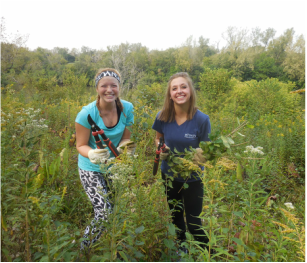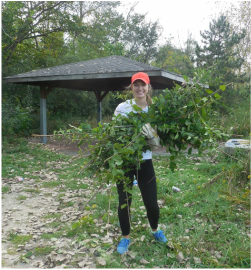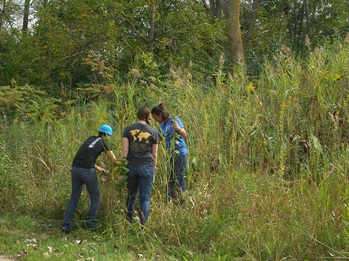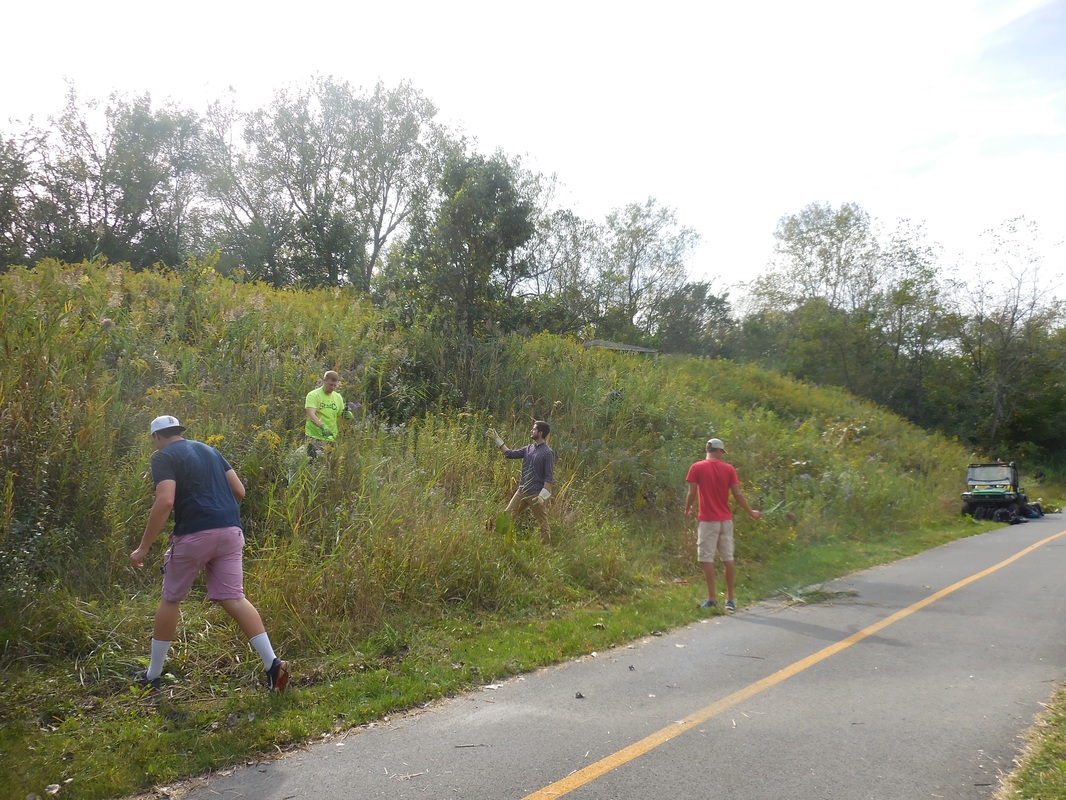|
Brittany & Leah with tools at the ready. Erin hauling out invasive plants.
I am happy to share another guest post from a student in Environmental Science. How can one best enjoy the first days of beautiful autumn briskness and weather? What better way than to benefit the environment by trimming back invasive species and promoting ecological restoration? On Thursday, September 24, Dr. Schrotenboer’s Environmental Science class was able to aid in the conflict against invasive plant species in a hands-on lab session. Only about a five-minute walk from Trinity Christian College’s campus, the class was introduced to Shamim Graff, a specialist at Lake Katherine. After a brief, physical explanation of our target victims, the class got to work along the hillside prairie, cutting down and removing harmful plant species such as Buckthorn, Teasel, and Honeysuckle. But why go through all the work of removing these plants in the first place? Years ago, before human settlement, Lake Katherine would have been an untouched wooded, prairie, and wetlands landscape, filled with native plant species that grew and flourished harmoniously. However, as civilization arrived and settled in the region, foreign plant species began to feel very at home, as well. Before long, the unmonitored intruders began choking native species as they quickly reproduced, blocked out sunlight, and altered the soil balance; crucial elements to survival and health of the pre-existing plants. Additionally, as Graff added, “Invasive plant species can be very tricky to remove. Buckthorn, for instance, should only be removed by trimming, as pulling by the roots will upset the soil. Control burn can sometimes be an effective approach to a more permanent elimination, but in today’s day-in-age the actually undertaking can be difficult to coordinate and monitor.” Ultimately, the day proved successful with large areas of prairie cleared, plenty of fresh air, and trivial poison ivy exposure. Students experienced a valuable lesson in ecological care and restoration, with a special benefit being the project area was located in the campus’ own backyard. ~Leah Taylor
0 Comments
This is a guest post written by a student in my Environmental Science class this fall. On the fateful afternoon of Thursday, September 24, 2015, the students in Environmental Science from Trinity Christian College marched toward Lake Katherine, led by their fearless leader, Commander S. While dodging cars and carrying their packs under the hot sun, the students were preparing for battle with the aliens that had landed next to the Cal-Sag trail. Upon arrival, they were greeted by the forward officer who had been holding down the fort, Shamim Graff. General Graff gave directions on how to identify the invaders who had camouflaged themselves into the hillside, and soon the battle began. But these aliens could not be fought with lightsabers or phasers – instead they had to be fought with clippers and gloves, for these aliens were not extra-terrestrial beings, they were invasive plants. Long before the Chicagoland was settled, the area now known as Lake Katherine flourished with native species: switchgrass, milkweed, oak trees, and many more. But as the area became more urban and people began planting foreign flowers and trees for aesthetic reasons, the native species began to disappear as the new species took hold, stealing valuable resources such as sunlight and soil nutrients. Buckthorn, Phragmites, and Teasel all began to grow, replacing the natural prairie with foreign plants. Because of this, efforts have been made to remove the invasive species, and promote native species, so that the natural ecosystem can continue to exist. Many animals and insects depend on the native species, and would die out with the native species. Removal of the invasive species allows the native species to get the sunlight and nutrients they need and have ample space to grow and flourish again. The battle was fierce. “These things are everywhere!” quipped Sergeant Brady Otte as he chopped down another Phragmites plume. One particular challenge was the steep slope on which the plants were growing. Students had to discern what plants were invasive as they clung to the side of the hill, wary of tumbling to the trail below. Luckily, no students fell as they worked, but many who had foregone gloves experienced small cuts on their hands, and students wearing shorts frequently checked for poison ivy. By the end of the day, the hill had been cleared of invasive species leaving the native plants behind, and the students were victorious. Commander S. gave the following summary during the victory celebrations: “It is really rewarding to see the work that can be accomplished with so many people working hard at removing the invasive species. By removing the shrubs that could shade the prairie, we are allowing a lot more light to reach the prairie plants, which will help them thrive.” Clearly the actions of the students had a positive impact on the ecosystem of the lake, and the students marched back to campus, celebrating their victory. ~Lucas Vander Wal |
Abbie SchrotenboerI'm a biology professor at Trinity Christian College. I'll be using this page to share interesting stories related to ecology and conservation at Trinity and in the Chicago area (although I might be tempted to expand my geographic focus upon occasion). Archives
December 2020
Categories |




 RSS Feed
RSS Feed
